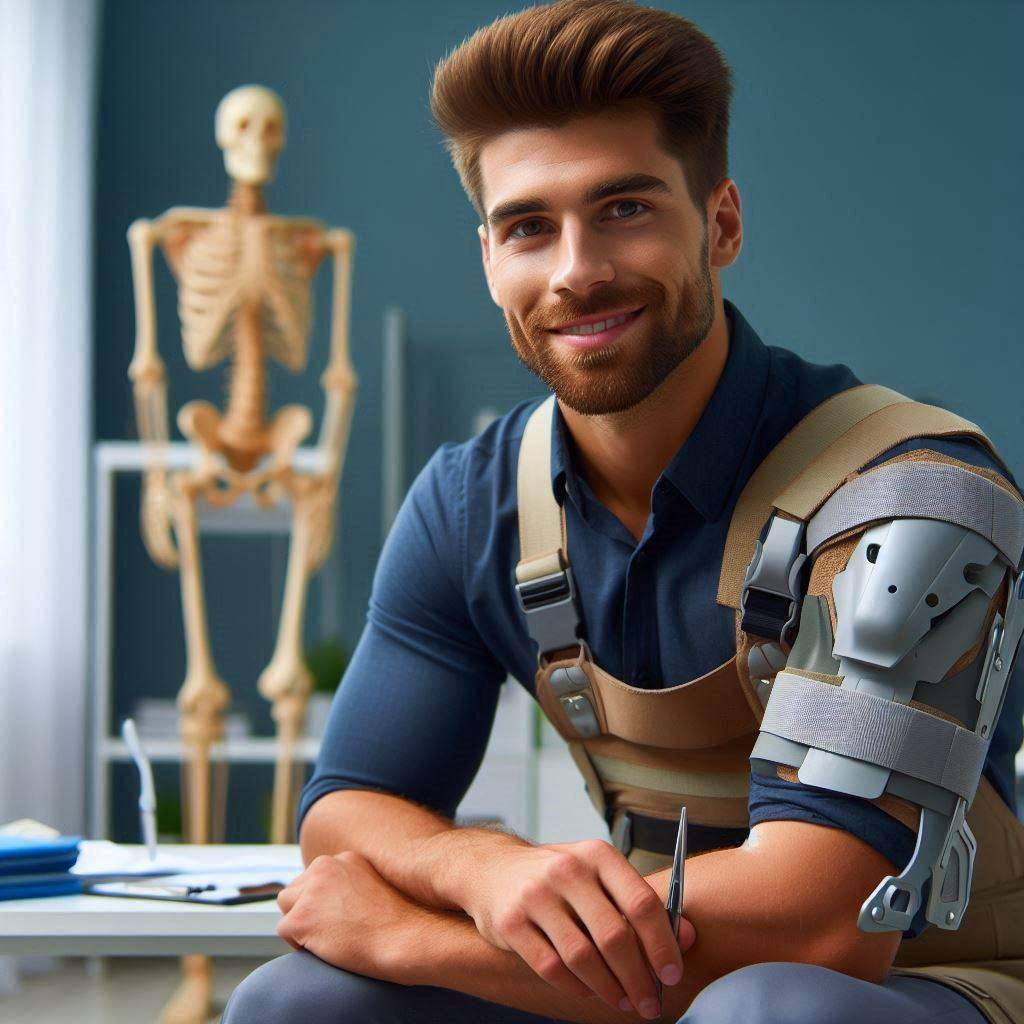Introduction
In this blog post, we will explore Orthotist Prosthetist Work Environments.
Orthotists and prosthetists play crucial roles in the healthcare industry by designing and fitting medical supportive devices and prosthetics.
Their work is integral to enhancing mobility and quality of life for patients.
These specialized professionals can be found in diverse work environments, ranging from bustling hospital settings to individualized private practices.
In hospitals, orthotists and prosthetists collaborate closely with medical teams to assess patients’ needs and provide tailored orthotic or prosthetic solutions.
Private practice settings offer orthotists and prosthetists the opportunity for more personalized patient care.
Here, they can develop long-term relationships with patients, focusing on continuous improvement and adjustments to ensure optimal device functionality and comfort.
The flexibility of private practice allows orthotists and prosthetists to innovate and customize devices according to individual patient lifestyles and preferences.
This environment fosters creativity and patient-centered care, often resulting in highly personalized solutions.
Overall, whether in the structured environment of a hospital or the personalized setting of private practice, orthotists and prosthetists remain dedicated to improving patients’ mobility and enhancing their overall quality of life through the application of advanced prosthetic and orthotic technologies.
Work Environment 1: Hospitals
Working as an orthotist/prosthetist in a hospital setting can be both challenging and rewarding.
In this environment, professionals are tasked with creating, fitting, and adjusting orthotic and prosthetic devices for patients with various musculoskeletal conditions and amputations.
Description of typical tasks in a hospital setting
In a hospital, orthotist/prosthetists work closely with physicians, physiotherapists, and occupational therapists to assess patients’ needs and design custom orthotic and prosthetic devices.
They take measurements, create molds, fabricate devices, and ensure proper alignment and fit for each patient.
Collaboration with other healthcare professionals
Collaboration is key in a hospital setting. Orthotist/prosthetists work as part of a multidisciplinary team to ensure that patients receive comprehensive care.
They consult with physicians to understand the patient’s condition, collaborate with therapists to optimize device functionality, and communicate with nurses to address any concerns or issues that may arise.
Exposure to various medical conditions and patient populations
Working in a hospital exposes orthotist/prosthetists to a wide range of medical conditions and patient populations.
They may work with patients recovering from traumatic injuries, those with congenital disabilities, or individuals with degenerative diseases.
This exposure allows professionals to develop a diverse skill set and experience different challenges that come with each unique case.
Overall, working in a hospital as an orthotist/prosthetist provides a dynamic and enriching environment where professionals can make a significant impact on patients’ lives and collaborate with other healthcare providers to deliver comprehensive care.
Transform Your Career Today
Unlock a personalized career strategy that drives real results. Get tailored advice and a roadmap designed just for you.
Start NowRead: Orthotist/Prosthetist Clinics: Setting Up Your Practice
Work Environment 2: Rehabilitation Centers
In rehabilitation centers, orthotists/prosthetists play a crucial role in helping patients recover and regain mobility.
They focus on designing and fitting prosthetic/orthotic devices tailored to each patient’s specific needs.
Orthotists/prosthetists work closely with physical therapists and occupational therapists to ensure optimal patient care.
Role in Helping Patients Recover and Regain Mobility
Orthotists/prosthetists in rehabilitation centers are instrumental in aiding patients in their recovery process.
They assess the patients’ needs and create customized prosthetic or orthotic devices to support their rehabilitation.
By providing these devices, they enable patients to regain mobility and independence in their daily lives.
Orthotists/prosthetists guide patients through the fitting process, ensuring comfort and functionality.
Focus on Designing and Fitting Prosthetic/Orthotic Devices
A significant aspect of the work environment in rehabilitation centers is the design and fitting of prosthetic/orthotic devices.
Orthotists/prosthetists use their expertise to create devices that align with patients’ physical characteristics and functional abilities.
These devices can range from simple braces to complex prosthetic limbs, depending on the patient’s needs.
The goal is to enhance the patients’ mobility and quality of life through precise device design and fitting.
Working Closely with Physical Therapists and Occupational Therapists
Collaboration with physical and occupational therapists is vital in the rehabilitation process.
Orthotists/prosthetists coordinate with therapists to ensure a comprehensive approach to patient care.
They exchange insights and updates on patients’ progress to adjust and optimize treatment plans.
This teamwork fosters a holistic and integrated approach to rehabilitation, focusing on improving patients’ overall well-being.
By working in rehabilitation centers, orthotists/prosthetists contribute to the multidisciplinary effort to help patients recover and regain their mobility.
They play a key role in designing and fitting prosthetic/orthotic devices, collaborating closely with other healthcare professionals for optimal patient outcomes.
This environment allows orthotists/prosthetists to make a meaningful impact on patients’ lives and facilitate their journey towards improved physical function and quality of life.
Read: Orthotist/Prosthetist Equipment: Essential Tools and Gadgets
Transform Your Career Today
Unlock a personalized career strategy that drives real results. Get tailored advice and a roadmap designed just for you.
Start NowWork Environment 3: Private Practices
Independence and autonomy in decision-making
In private practices, orthotists and prosthetists have the freedom to make critical decisions autonomously.
This independence allows them to customize treatments and solutions based on the specific needs and preferences of each patient.
They can choose from a variety of materials, designs, and technologies to create prosthetics or orthotics that best suit individual lifestyles and requirements.
This level of autonomy not only enhances the efficiency of patient care but also fosters innovation and continuous improvement in practice.
Building long-term relationships with patients
Private practice settings provide orthotists and prosthetists with the opportunity to establish deep, long-term relationships with their patients.
Unlike larger healthcare settings where interactions may be more transient, in private practices, professionals often see patients over extended periods.
This continuity allows them to develop a comprehensive understanding of each patient’s medical history, lifestyle, and personal goals.
By forging these strong connections, orthotists and prosthetists can better address the evolving needs of their patients, providing ongoing support and adjustment to ensure optimal comfort and functionality of prosthetic or orthotic devices.
Opportunities for specialization in specific areas
Private practices offer orthotists and prosthetists avenues to specialize in specialized areas such as sports prosthetics or pediatric orthotics.
Sports prosthetics focus on enhancing athletic performance and recovery by designing prosthetic limbs that optimize movement and endurance.
Pediatric orthotics specialize in developing orthotic devices tailored to the unique growth and development needs of children, ensuring comfort and support throughout their growth stages.
These specialized areas allow professionals to deepen their expertise, collaborate with other healthcare providers, and contribute significantly to improving the quality of life for patients with specific needs.
Read: How Orthotists/Prosthetists Improve Quality of Life for Patients

Work Environment 4: Prosthetics and Orthotics Labs
Manufacturing and customizing prosthetic/orthotic devices
Prosthetists and orthotists in specialized labs undertake the precise manufacturing and customization of prosthetic and orthotic devices.
Each device is meticulously crafted to meet the unique needs and anatomical specifications of individual patients.
The process involves detailed assessments of patient requirements, taking into account factors like mobility goals, comfort, and durability.
By leveraging their expertise in biomechanics and materials science, these professionals ensure that each device is tailored to provide optimal support and functionality.
The manufacturing phase includes precise measurements, modeling, and fabrication techniques to create devices that seamlessly integrate with the patient’s body.
Utilizing advanced technology and 3D printing
Modern prosthetics and orthotics labs integrate advanced technologies, prominently featuring 3D printing capabilities.
This technology allows for the creation of highly personalized devices with unmatched precision and speed.
Transform Your Career Today
Unlock a personalized career strategy that drives real results. Get tailored advice and a roadmap designed just for you.
Start NowDesign specifications derived from patient assessments are translated into digital models, which are then fabricated layer by layer using specialized materials.
3D printing offers benefits such as rapid prototyping, customization of intricate designs, and the ability to adjust devices based on patient feedback.
It enhances efficiency in production while maintaining high standards of quality and precision.
The integration of digital technologies ensures that prosthetists and orthotists can deliver innovative solutions that improve patient outcomes and overall quality of life.
Quality control and testing of devices before fitting
Quality control processes are integral to prosthetics and orthotics labs, ensuring that every device meets stringent standards before being fitted to patients.
Rigorous testing protocols verify the functionality, durability, and safety of each device.
This includes biomechanical testing to assess how the device interacts with the patient’s body during movement.
Additionally, quality control measures ensure that materials used meet regulatory requirements and contribute to the longevity of the device.
Thorough inspections and adjustments are conducted to guarantee comfort and proper alignment before the final fitting.
By prioritizing quality assurance, prosthetics and orthotics labs uphold their commitment to delivering reliable and effective solutions that enhance the mobility and quality of life for their patients.
Read: Orthotist/Prosthetist Success Stories: Inspiring Journeys
Work Environment 5: Research and Development
Orthotists and prosthetists play a crucial role not only in patient care but also in advancing the field through research and development (R&D).
Here’s how they contribute to advancements in orthotics and prosthetics:
Contribution to advancements in orthotics/prosthetics field
Orthotists and prosthetists are at the forefront of developing new technologies and techniques to enhance patient mobility and comfort.
Their hands-on experience with patients gives them unique insights into practical improvements that can be made.
Testing new materials and designs for better patient outcomes
In R&D environments, orthotists and prosthetists test and evaluate new materials and designs rigorously.
They aim to enhance durability, functionality, and aesthetics of orthotic and prosthetic devices, ensuring they meet the specific needs of individual patients.
Collaboration with engineers and researchers to innovate
Collaboration is key in R&D settings. Orthotists and prosthetists work closely with engineers, material scientists, and biomedical researchers to innovate.
This interdisciplinary approach leads to breakthroughs in device design, material selection, and manufacturing processes.
By engaging in research, orthotists and prosthetists contribute to the broader healthcare community’s understanding of mobility solutions.
Transform Your Career Today
Unlock a personalized career strategy that drives real results. Get tailored advice and a roadmap designed just for you.
Start NowTheir work not only improves the quality of life for current patients but also sets the stage for future innovations in orthotics and prosthetics.
In a nutshell, the role of orthotists and prosthetists in research and development is pivotal.
Through their dedication to innovation and collaboration, they continue to push the boundaries of what is possible in improving patient care and quality of life.
Conclusion
Orthotists and prosthetists play pivotal roles in healthcare, enhancing mobility and quality of life for patients.
From hospital settings where acute care meets innovation, to private practices offering personalized patient care, these professionals thrive in diverse environments.
In hospitals, orthotists/prosthetists collaborate closely with medical teams, crafting solutions that restore function and comfort for patients recovering from injuries or surgeries.
This setting demands adaptability and quick decision-making, crucial in emergency and post-operative care.
Conversely, private practices allow orthotists/prosthetists to build long-term relationships with patients, tailoring devices to individual needs.
This environment fosters creativity and patient-centered care, focusing on improving daily living and mobility over time.
Aspiring orthotists/prosthetists are encouraged to explore these varied career paths, each offering unique challenges and rewards.
Whether in a bustling hospital or a patient-focused private clinic, the impact on patients’ lives remains profound and fulfilling.
In summary, the field of orthotics and prosthetics offers dynamic opportunities across different work environments.
Understanding these settings not only expands career possibilities but also enriches the practice with diverse experiences.
Embrace the journey towards becoming an orthotist or prosthetist, where innovation meets compassion in transforming lives.




